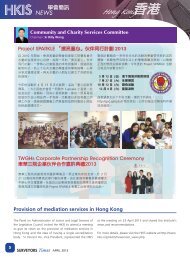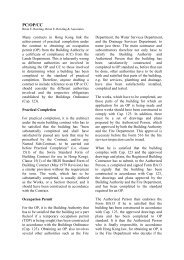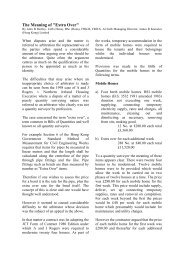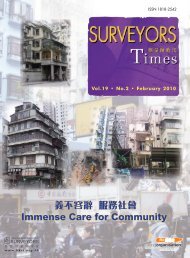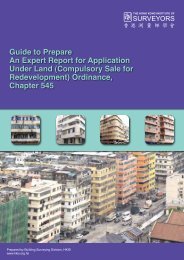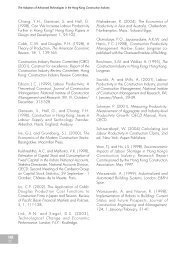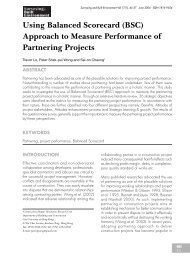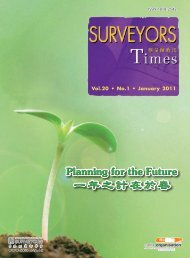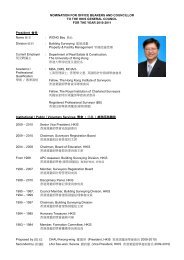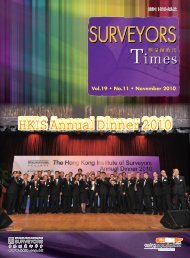Surveying & Built Environment Vol. 22 Issue 1 (December 2012)
Surveying & Built Environment Vol. 22 Issue 1 (December 2012)
Surveying & Built Environment Vol. 22 Issue 1 (December 2012)
Create successful ePaper yourself
Turn your PDF publications into a flip-book with our unique Google optimized e-Paper software.
Footnote 43 in Cheung’s (1975) work<br />
states, “In a forthcoming book which<br />
investigates various rent controls in<br />
Hong Kong (Cheung, in progress),<br />
detailed evidence will be presented to<br />
confirm that premature reconstructions<br />
occurred in some tenements protected<br />
by the Landlord and Tenant Ordinance<br />
during the postwar period.” (Cheung<br />
1975: p.15) That book has not yet<br />
appeared. Cheung’s (1979) paper on<br />
housing reconstruction in post-war<br />
Hong Kong examines, among other<br />
things, 185 Land Tribunal cases heard<br />
from 1969 to 1972 in relation to s.11 (A)<br />
of the Landlord and Tenant Ordinance.<br />
In that later paper the focus shifts from<br />
reconstruction as a means used by the<br />
landlord to circumvent any rent cap to:<br />
(a) the landlord’s drive to<br />
reconstruct to minimise loss due<br />
to the introduction in 1962 of<br />
plot ratio control in the Buildings<br />
Ordinance, which reduced the<br />
permitted floor area; and<br />
(b) overcoming tenants<br />
who were holding out when<br />
landowners find it more<br />
profitable to redevelop<br />
In this latter regard s.11 (A), introduced<br />
in 1968 to allow private negotiation<br />
between landlord and tenant, was<br />
found useful in preventing premature<br />
redevelopment by overcoming the<br />
holding out problem.<br />
Cheung’s (1974) theory of price control<br />
covers all types of regulation of the<br />
market and thus one should appreciate<br />
that his (1979) case study demonstrates<br />
well the predictive power of his theory.<br />
Nonetheless, evidence remains wanting<br />
of pre-mature redevelopment intended<br />
<strong>Surveying</strong> and <strong>Built</strong> <strong>Environment</strong> <strong>Vol</strong> <strong>22</strong>, 88-90 Nov <strong>2012</strong> ISSN 1816-9554<br />
only to by-pass rent control itself rather<br />
than any other form of control, yet<br />
that was nonetheless not a response to<br />
growing demand.<br />
In the light of this, we can turn to a<br />
University of Hong Kong dissertation<br />
by Lu (2007) on architectural<br />
conservation in Kadoorie Hill,<br />
developed and owned substantially by<br />
Hongkong Engineering & Construction<br />
Company Ltd., controlled by the<br />
famous Kadoorie family. This does<br />
provide real life, post-war evidence in<br />
support of Cheung’s (1975) theory of<br />
pre-mature redevelopment due to rent<br />
control.<br />
Lu’s (2007) dissertation recorded that<br />
the 1980 annual report of this company<br />
stated,<br />
“as prewar properties are not<br />
subject to the control of Landlord<br />
and Tenant (Consolidation)<br />
(Amendment) Ordinance 1980,<br />
the renewal rentals of the<br />
Company’s pre-war properties<br />
have been brought up to<br />
realistic levels as have other<br />
properties upon vacation by<br />
tenant...it has been decided not<br />
to proceed with the demolition<br />
and re-development of six of the<br />
Company’s small pre-war houses<br />
in Kadoorie Avenue...Instead,<br />
complete renovation of some<br />
of the houses is under active<br />
consideration.” (Lu, p.39 of the<br />
e-thesis)<br />
This is the public statement of a<br />
landlord in relation to rent control.<br />
This piece of information supports<br />
Cheung’s (1975) theory. One year<br />
earlier, the company had expressed<br />
worries about the adverse effects of a<br />
SBE<br />
89



